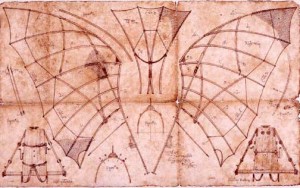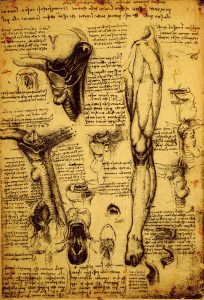Veni, Vidi, Da Vinci
What made Leonardo da Vinci a genius? I’ve just finished Walter Isaacson’s all-purpose biography of the Italian Renaissance man and four words come to mind: curiosity, observation, analogy, and humility. These four traits combined and recombined throughout Leonardo’s life to create advances in painting, engineering, architecture, anatomy, hydrology, optics, weaponry, and theater.
Leonardo maintained a childlike curiosity throughout his life. Every kid wants to know why the sky is blue. As we reach adulthood, most of us simply accept the fact that the sky is indeed blue. Not Leonardo. He studied the question for much of his adult life and ultimately developed an explanation based on clear evidence and careful reasoning.
Leonardo combined his curiosity with powers of observation that beggar belief. He noticed, for instance, that dragonflies have four wings, two forward and two aft. He wondered how they worked. By close observation, he concluded that when the two forward wings go up, the two aft wings go down. It seems like a simple observation but it must have taken hours of acute and disciplined observation.
Similarly, he took an interest in how birds flap their wings. Do their wings move faster as they flap upward or downward? Most of us would not conceive of such a question, much less focus our attention sufficiently to answer it. But Leonardo did, not once but several times.
His first observations – taken over many hours and days – suggested that birds flap their wings faster on the down stroke. At this point, I would have recorded my observation, concluded that all birds behaved similarly, and moved on. But Leonardo persisted. He observed different bird species and found that some flap faster on the up stroke than the down stroke. Wing behavior differs by species. It’s an interesting observation about birds. It’s a fascinating observation about Leonardo. Arthur Bloch once said that, “A conclusion is the place where you get tired of thinking.” Leonardo, apparently, never got tired of thinking. He recognized that all conclusions are tentative.
Leonardo didn’t just study insects and birds. He studied pretty much everything – from rivers to trees to pumps to blood circulation to optical effects to anatomy to geometry to Latin to … well, whatever caught his eye. His breadth of knowledge allowed him to draw analogies that others would have missed. Some of his analogies seem “obvious” to us today – like the analogy between water flow in rivers and blood flow in humans.
But how about the analogy between arteriosclerosis and oranges? As he dissected cadavers, Leonardo noticed that older people’s arteries were often less flexible and more clogged that those of younger people. He became the first person in history to accurately describe arteriosclerosis. He did so by comparing it to the rind of an orange that dries, stiffens, and thickens as it ages.
In today’s world, expertise is often associated with narrowness. Experts gain ever more knowledge about ever-narrower subjects. Leonardo was certainly an expert in several narrow domains. But he also saw across domains and could think outside the frame. Philip Tetlock, an authority on political judgment, suggests that this ability to think across boundaries is a key ingredient to insight and discovery. In many ways, Leonardo thought more like a fox and less like a hedgehog.
If I could think and observe like Leonardo, I might become a bit of a prima donna. But Leonardo never did. He remained humble and diffident in an ever-changing world. As Isaacson notes, he “… relished a world in flux.” Further, “When he came up with an idea, he devised an experiment to test it. And when his experience showed that a theory was flawed … he abandoned his theory and sought a new one.” By revising and updating his own conclusions, Leonardo helped establish a world in which observation and experience trump dogma and received wisdom.
Leonardo’s legacy is so broad and so varied that it’s difficult to encapsulate succinctly. But Isaacson includes a quote the German philosopher, Schopenhauer, that helps us understand his impact: “Talent hits a target that no one else can hit. Genius hits a target that no one else can see.”
Was Leonardo Da Vinci Innovative?

Let’s tweak it, Leo.
We all know that Leonardo Da Vinci was a genius. But was he innovative?
The question draws a distinction between invention and innovation and between creativity and construction. As Wikipedia puts it, “[Da Vinci] conceptualized a helicopter, a tank, concentrated solar power, an adding machine, and the double hull, also outlining a rudimentary theory of plate tectonics. Relatively few of his designs were constructed or were even feasible during his lifetime….”
In other words, Leonardo had great ideas but many of them were never implemented. So, were they innovations?
That leads to another question: why did Britain lead the way in the Industrial Revolution? Other countries – notably France, Germany, Italy, and Sweden – had great universities and well established scientists and laboratories. Why did Britain create the industrial surge while others followed?
That’s the question that Ralf Meisenzahl and Joel Mokyr address in their working paper published by the National Bureau of Economic Research. Their short answer: Britain didn’t have more geniuses than other countries, but it did have more tweakers and implementers.
Meisenzahl and Mokyr argue that Britain certainly had its fair share of “hall-of-fame” inventors. But many of those genius ideas would not have been turned into practical innovations if not for “…a group of skilled workmen who possessed the training and natural dexterity to … carry out the ‘instructions’ contained in the … blueprints, … build the parts … with very low degrees of tolerance, and … fill in the blanks when the instructions were inevitably incomplete.”
Meisenzahl and Mokyr try to distinguish between tweakers and implementers. Tweakers “…improved and debugged an existing invention.” Implementers were “…skilled workmen capable of building, installing, operating and maintaining, new and complex equipment.”
Meisenzahl and Mokyr identified 758 men and one woman (Elenor Coade “who invented a new process for making artificial stone…”) whom they could classify as tweakers or implementers. Each person in the database was born between 1660 and 1830. Meisenzahl and Mokyr studied the industries they worked in, what they did, how they were incented, and how they acquired their skills. Among their key findings:
- The apprenticeship system was critical – it produced not only knowledge but also the skill to produce finely tuned machines. It also provided talented youngsters with a stable environment while they acquired and honed their skills.
- Multiple incentives were available. Much has been made of the British patent system in spurring innovation. But the authors argue that a system of prizes was equally or more important. Organizations such as the Society of Arts offered prizes for the development of specific devices, such as a machine to manufacture lace. Many such prizes were awarded “on the condition … that no patent was taken out” – which allowed the innovation to spread more rapidly.
- A “mechanical culture” – the authors point out that, “The second half of the eighteenth century witnessed the maturing of the Baconian program, which postulated that useful knowledge was the key to social improvement. In that culture, technological progress could thrive.”
So Britain not only had its fair share of geniuses but also had a well organized cadre of people who could tweak, improve, and implement the ideas the geniuses handed on. Just think what Leonardo might have done.
